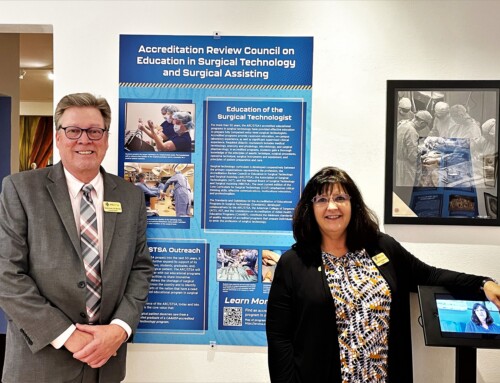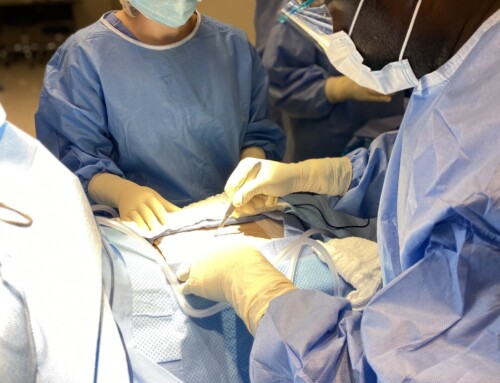By Jinnie Gardiner CSFA, FAST, AA, Surgical Technology Program Director, North-West College
Many of our students struggle to use their imagination to visualize, understand and memorize information. While traditional teaching methods (books, PowerPoint presentations) have a place, they do not always help students retain information. My father was an “inventor” of sorts and taught me how to find extraordinary use for ordinary items. Over the years I have successfully used his outside-the-box mentality to bring new concepts to students. Here I’ll share a few ideas that have been fun for our students and helped them retain information.
So, what can be done with butcher paper, bubble wrap and powdered lemonade?
 Butcher Paper: The skeletal system is one of the easier systems to learn, but students still have difficulty retaining which bone is in which part of the body. The answer lies within a roll of butcher paper.
Butcher Paper: The skeletal system is one of the easier systems to learn, but students still have difficulty retaining which bone is in which part of the body. The answer lies within a roll of butcher paper.
One student lies on a pre-cut piece of butcher paper and another traces the student. A team of two or three students draws and labels the bones of the skeleton. This art project has helped our students better retain the names of bones and their locations. They have fun and team-build while learning. We have also used this effective method for the muscular, cardio and peripheral vascular systems.
Bubble Wrap (large bubbles preferred): Clamp, clamp, cut, tie, tie without injuring a structure. Students many times have a difficult time understanding these basic surgery steps. They watch video demonstrations, but most of our students learn best with hands-on training. This is where the bubble wrap can help.
The bubble wrap becomes a mock cyst — after all, cysts are just fluid filled sacs. Follow these steps:
- Create the cyst by carefully cutting around a single bubble from large bubble wrap, leaving a free edge to attach to the cyst pocket.
- Use a 60cc syringe and pour fluid of choice into the 60cc syringe. This is where you can get creative with paint, food coloring, or even add an odor. I prefer using hair conditioner because if the “cyst” were to rupture, I do not want to stain the manikin.
- Attach an 18- or 19-gauge needle to the syringe. Use the needle to inject the back of bubble with “cyst fluid.”
- To seal the puncture, use a small piece of scotch tape, or packing tape. Check for leaks or ruptures.
- Next, make the cyst pocket. Start by cutting a piece of 3-inch by 3-inch felt — this will be the back wall for the cyst pocket.
- Make the muscle layer by using a red piece of 3-inch by 3-inch fabric, and layer it on top of the felt from the previous step.
- Attach the cyst to the muscle layer. You can use thread, suture or staples to attach.
- Then, make a blood vessel by using a piece of red yarn to put over cyst. Attach similarly as done with cyst attachment.
- Use a sheer (nearly transparent) 3-inch by 3-inch piece of fabric and layer on top of cyst. This will represent the fascia layer.
- For the final layer, use a skin-tone, 3-inch by 3-inch piece of fabric to cover fascia layer.
- As a final step, secure together layer edges of cyst pocket using thread, suture or staples.
For the cyst removal procedure, attach the cyst to various parts of the manikin. It can be a chest cyst, ganglion or even pilonidal cyst. Students can take turns being the surgeon. They learn how to be gentle with tissue structures when excising tissue. Most importantly, they learn the basic principles of clamp, clamp, cut, tie, tie by having the opportunity to be in the role of the surgeon.
Powdered lemonade: A very rare situation that can happen in surgery is a Malignant Hyperthermia (MH) crisis. As a new tech, I experienced my first of two MH crises. I learned the importance of correct dosages, and that speed in administering emergency medications were key to saving the patient’s life.
As an instructor, how do we teach this? To think outside the box, I looked inside a container of powdered lemonade. It’s the same color as dantrolene and both need to be mixed similarly.
In our class, we removed the lid from an empty, dry medication bottle, filled it halfway with powdered lemonade and resealed the lid to the bottle. Now we were ready to run our MH crisis.
To set up the scenario, we posted MHAUS signs with emergency numbers in the room and made an MH cart — complete with Dantrolene (powdered lemonade), other faux emergency medications, bags for ice, IV start kits, IV tubing, 60cc syringes, cooling blanket, ABG blood tubes and biohazard bags for blood gas tubes. Other props included a crash cart with AED (you can use an AED trainer), IV training arm, ice chest with ice and a recorded sound of a tachycardia and flat line.
Every student was assigned a role for the MH crisis. In each class that we have run this mock crisis, it has taken at least eight to nine minutes to get one full bottle of Dantrolene into the patient, who needs 12-13 bottles. Students have learned it takes a large team that knows what they are doing, to work very quickly to save the patient in an MH crisis.
For added fun with our students, I have written the lyrics for an MH crisis song, set to the tune of “Its Beginning to Look a lot like Christmas”:
It’s beginning to look a lot like trismus, with his clenching jaw
There’s a man with rigidity in his extremities, a tightness he feels all throughout his limbs
It’s beginning to look a lot like trismus, soon the boiling will begin
And the cause of his infermia, is malignant hyperthermia, surging in his core
He’ll need Dantrolene, and some more.
(Lyrics by Jinnie Gardiner)
Look around you. What ordinary objects can be used to help your students learn in new ways? Think outside the box and look inside a container of powdered lemonade.



